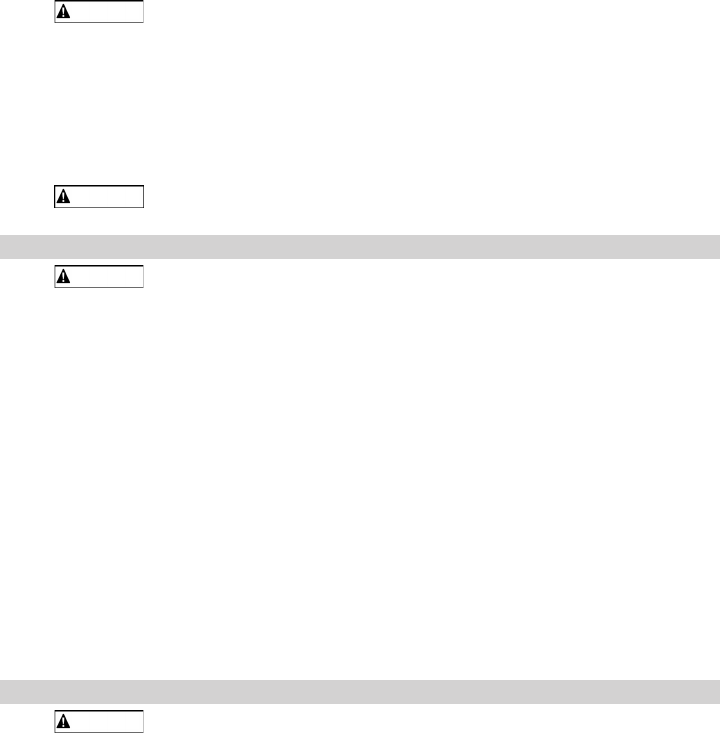
• 3 •
1.5 Do not disassemble the charger; take it to a qualied service person when service or
repair is required. Incorrect reassembly may result in a risk of re or electric shock.
WARNING
RISK OF EXPLOSIVE GASES.
1.6 WORKING IN THE VICINITY OF A LEAD-ACID BATTERY IS DANGEROUS.
BATTERIES GENERATE EXPLOSIVE GASES DURING NORMAL BATTERY
OPERATION. FOR THIS REASON, IT IS OF UTMOST IMPORTANCE THAT YOU
FOLLOW THE INSTRUCTIONS EACH TIME YOU USE THE CHARGER.
1.7 To reduce the risk of a battery explosion, follow these instructions and those published
by the battery manufacturer and the manufacturer of any equipment you intend to use
in the vicinity of the battery. Review the cautionary markings on these products and on
the engine.
WARNING
Do not use with non-rechargeable batteries. Use only with lead-acid type
rechargeable batteries.
2. PERSONAL PRECAUTIONS
WARNING
RISK OF EXPLOSIVE GASES.
2.1 Remove personal metal items such as rings, bracelets, necklaces and watches when
working with a lead-acid battery. A lead-acid battery can produce a short-circuit current
high enough to weld a ring or the like to metal, causing a severe burn.
2.2 Be extra cautious, to reduce the risk of dropping a metal tool onto the battery. It might
spark or short-circuit the battery or other electrical part that may cause an explosion.
2.3 Use this charger for charging 12V LEAD-ACID batteries only. It is not intended to supply
power to a low voltage electrical system. Do not use this battery charger for charging
dry-cell batteries that are commonly used with home appliances. These batteries may
burst and cause injury to persons and damage to property.
2.4 NEVER charge a frozen battery.
2.5 NEVER overcharge a battery.
2.6 Consider having someone nearby to come to your aid when you work near a
lead-acid battery. Have plenty of fresh water and soap nearby in case battery acid
contacts your skin, clothing or eyes.
2.7 If battery acid contacts your skin or clothing, immediately wash the area with soap and
water. If acid enters your eye, immediately ood the eye with cold running water for
at least 10 minutes and get medical attention right away. If battery acid is accidentally
swallowed, drink milk, the whites of eggs or water. DO NOT induce vomiting. Seek
medical attention immediately.
3. PREPARING TO CHARGE
WARNING
RISK OF CONTACT WITH BATTERY ACID. BATTERY ACID IS A HIGHLY
CORROSIVE SULFURIC ACID.
3.1 Remove all cord wraps and uncoil the cables prior to using the battery charger.
3.2 If it is necessary to remove the battery from the vehicle to charge it, always remove
the grounded terminal rst. Make sure all of the accessories in the vehicle are off to
prevent arcing.
3.3 Clean the battery terminals before charging the battery. During cleaning, keep airborne
corrosion from coming into contact with your eyes, nose and mouth. Use baking soda
and water to neutralize the battery acid and help eliminate airborne corrosion. Do not
touch your eyes, nose or mouth.
3.4 Add distilled water to each cell until the battery acid reaches the level specied by the
battery manufacturer. Do not overll. For a battery without removable cell caps, such
as valve regulated lead acid batteries (VRLA), carefully follow the manufacturer’s
recharging instructions.
3.5 Read, understand and follow all instructions for the charger, battery, vehicle and any
equipment used near the battery and charger. Study all of the battery manufacturer’s
specic precautions while charging and recommended rates of charge.
3.6 Make sure that the charger cable clips make tight connections.


















